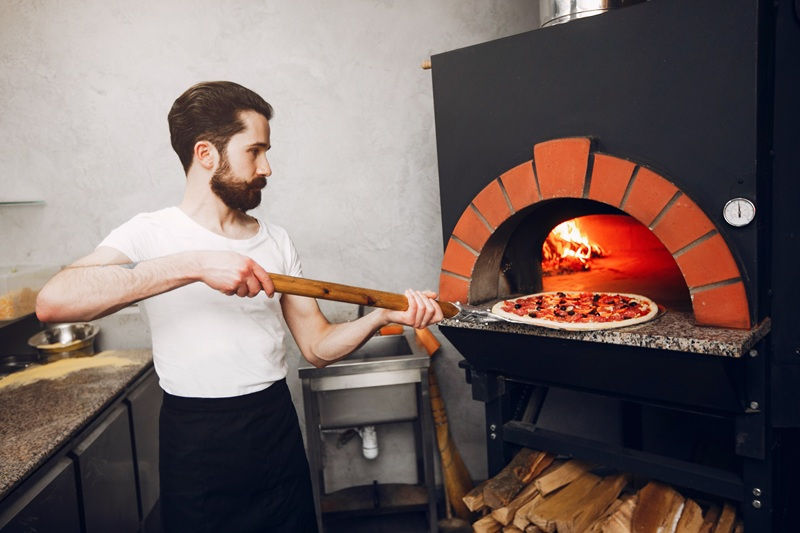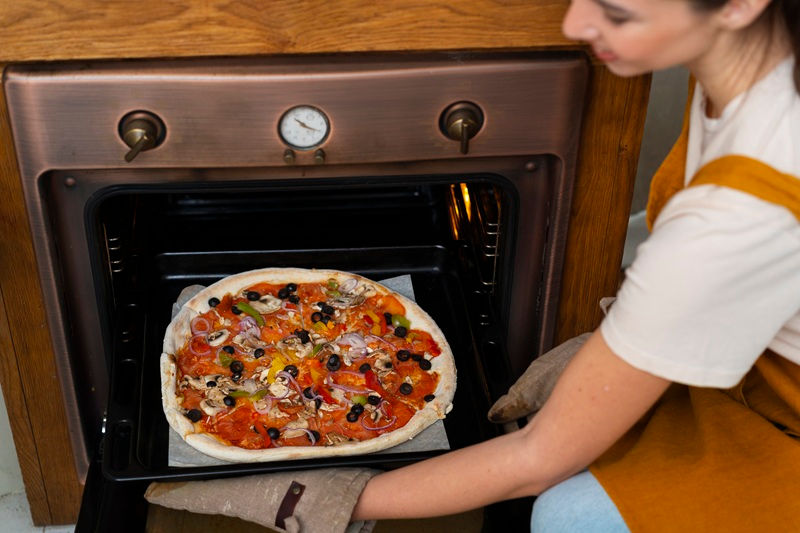Expert Tips for Maintaining Your Rotating Pizza Oven's Performance
- Ashley Kinsela
- Sep 27
- 6 min read
It has become apparent that the taste of your pizza isn't so much as enjoyable as it was when you bought your rotating pizza oven. You find yourself constantly battling with one side of your pizza burning while the other remains uncooked or constantly trying to achieve that perfect temperature. But what if a little maintenance turned around the whole pizza-making experience in your home?
A rotating pizza oven is much more than just having it cleaned. It symbolizes the way forward in outdoor cooking: with an expensive wood-fired oven or the ease of use provided by gas, everything else is in how well it is maintained or what meaning that gives to your wood-fired ovens. Earning the difference between average-quality pizzas and restaurant-quality results is, as with all other appliances, maintenance. Well-maintained ovens not only perform better but will also last you much longer, saving you a lot of dollars and frustration later.
In this guide there will be everything from best pizza oven tools and daily cleaning procedures to troubleshooting common problems and care for all seasons. You will know which pizza accessories are worth having, identify major issues before they grow into costly repairs, and draft a personalized maintenance schedule that fits seamlessly into your lifestyle. Time to get sucked into how best to keep your rotating pizza oven operating at its absolute best.
Essential Tools and Aids for Pizza Oven Maintenance
Essential Pizza Oven Utensils for Daily Care
You'll appreciate some good quality pizza cooking utensils in making the maintenance of your rotating pizza oven infinitely simpler. The mainstay of your maintenance kit should be a really good pizza peel: if you have a Gosney or similar top-brand model, buy their matching Gosney pizza peel to use. Look for peels with long handles that keep your hands safely removed from the heat; consider having both a launching peel (thinner, for sliding pizzas in) and a turning peel (smaller, for adjustments).
Your cleaning arsenal needs special attention too. Standard household brushes simply won't cut it when dealing with the extreme temperatures and delicate surfaces of your oven. Invest in brass-bristled brushes specifically designed for pizza oven supplies – they're tough enough to remove stubborn residue but gentle enough to protect your oven floor. Pair these with long-handled scrapers that can reach every corner of your rotating platform without requiring you to lean into the heat.
Best Cookware for Wood Fired Ovens
Choose wood fired oven cookware by not just the best-cooking standards, but by what will help preserve the surfaces in the interior of your oven. Cast iron makes it look shiny. It is really the hardiness standard for heat retention, which makes it perfect for roasting and baking. In all honesty, cast iron comes with maintenance, seasoning over a period of time, and keeping your pieces in an area free of rust.
An alternative to cast iron is stainless steel, which needs less maintenance, especially for rotating ovens. Because it is smooth, it won't scratch your oven floor when moving around, and good-quality stainless best cookware for wood fired oven should withstand numerous thermal cycling without warping. Just make sure you're buying proper heavy-gauge steel – thin pans will buckle under intense heat and could damage your rotating mechanism.
Daily and Weekly Maintenance Routines

How Often Should You Clean a Rotating Pizza Oven?
It really does depend on how often you burn that oven up. If you're running it full blast every day for commercial use, it is no option to clean it thoroughly after each and every use. If you are lucky enough to be a weekend warrior, cooking only once or twice a week, you can do with a quick brush down after cooking and a big clean once a week.
That said, special attention should be given to the rotating thing regardless of how many times it gets used. Even under very light use, flour and food crumbs accumulate in the gears and bearings. A quick inspection and brush-out after every use save these particles from hardening to problematic buildup. This simple habit adds only minutes to your routine but could stretch the life of your oven by years.
The Perfect Clean Down Process Post-Cooking
You should start your clean-down while the oven is still warm but not scorching hot – around 150°C is ideal. Now, this temperature makes it easy to get debris off without risking burns or thermal shock to your pizza utensils. Then, simply commence slowly rotating the platform while brushing, ensuring that all sections of the cooking surface get swept.
Ash removal in wood-fire ovens needs a very soft touch. Metal dustpan and brush-in used for the oven: not for house-cleaning purposes. Sweep ash to the oven mouth while preventing clouds from forming; nothing should be dirtied from rotting in the rotation mechanism. As for gas, collect every piece of leftover food, then wipe the interior walls off any grease splatter.
Weekly Deep Cleaning Techniques
Your weekly deep clean is when you really show your oven some love. Start by removing any removable parts that you would be able to move-in like cooking grates and heat diverters. These pieces of pizza oven equipment benefit from having a good soak in warm, soapy water while you tackle the main cavity of the oven.
The stone surface needs careful attention so that it retains its non-sticking properties as well as heat retention. Never use soap on the cooking stone - instead, use a dedicated stone cleaning solution or a paste made from baking soda and water. Work this into any stained areas with a soft brush, then wipe it clean with damp cloth. Allow stone to dry completely before next cook to avoid cracking.
Troubleshooting Common Performance Issues

Why Is My Pizza Oven Not Baking Hot Enough?
Most of the time, a temperature problem is due to poor fuel quality. If you are using wood, moisture above 20% will affect heat production significantly. Buy a moisture meter and burn only well-seasoned hardwood. Don't be deceived by the lower price of softwood; burning quick and dirty tends to produce an unmanageable level of residue that clogs your chimney.
The next most common mistake that most people make is by neglecting the insulation degradation. Check door seals also for gaps and damage as even a tiny leak increases inefficiency. Over time, the dome insulation settles or becomes less insulated, causing cold spots. Run your hand carefully around the exterior whilst the oven is hot (keeping a safe distance) to identify areas losing heat.
What Are the Causes of Unevenness in Cooking in a Rotating Pizza Oven?
This is most annoying in a rotating oven, as the assumption is that the rotation should resolve this problem. First, check whether the rotation speed lies within the parameters defined by the manufacturer. Too fast, and the food doesn't absorb enough heat per zone; too slow, and you might as well have a static oven.
Heat distribution problems develop, most of the time, gradually, with parts eventually wearing off. Check on your heat deflectors or on the baffles that might have gotten warped or displaced from their position. Ash at the bottom pile up and insulate parts of the floor in wood-fired ovens, so there produces much temperature variation. Also, consider your pizza making accessories placement; overcrowding in the oven disrupts air flow patterns necessary for even cooking.
Dealing with the Mechanical Faults of the Rotating Platform
A screech or grind from the rotation mechanism is not just irritating; it's actually telling you that your oven needs help. Begin with identifying all the lubrication points given in your manual. Use only food-grade lubricants rated as high temperatures. In most cases, mechanical issues would be prevented by lubricating every 20-30 cooking sessions.
If the lubrication does not help improve the issue, carefully consider the driving system. There may be teeth of worn gears, stretched chains, or broken bearings. Under thermal stress, small amounts of play between the components worsen really quickly. Taking photos during inspection helps you explain issues clearly if you need professional assistance.
Formulating Your Personalized Maintenance Schedule
Now that you've gotten the full picture of maintenance, you must be feeling a bit daunted at where to begin. Truth is that every rotating pizza oven setup is different, and yours should also highlight the specific differences among setups. Think about how often you cook, what kind of climate you live in, whether or not your oven lives outside year-round, and what your comfort level is with DIY-ing things.
The money you put into your rotating pizza oven, along with the quality pizza oven supplies, deserves appropriate care for protection. Regular care assures us that the oven will continue to bring fine cooking results and avoid those expensive surprises that come as a result of lack of care. Your oven should bring joy, not stress, and a well-maintained setup delivers precisely that. So, grab your cleaning tools, set up your schedule, and keep those perfect pizzas coming. Your future self (and dinner guests) will definitely be thankful for your effort today.



Comments